The nature of the excavation work being undertaken will affect the selection of an excavation method and a safe system of work. Careful consideration should be given to health and safety issues when planning the work where the excavation involves anything other than shallow trenching and small quantities of material.
Regulation 306 A person conducting a business or undertaking who proposes to excavate a trench at least 1.5m deep, must minimise the risk to any person arising from the collapse of the trench by ensuring that all sides of the trench are adequately supported by one or more of the following:
- shoring by shielding or other comparable means (for example boxing)
- benching, and
- battering.
A combination of these control measures may be the most effective depending on the work environment and characteristics of the excavated material. In built up areas or streets the excavation may have to be fully or partly sheeted or supported to prevent collapse due to localised vehicle movement.
Where a worker enters a trench and there is a risk of engulfment, these control measures should be implemented regardless of the depth of the trench.
A report from a geotechnical engineer may be required to provide information on the stability and safety of a trench excavation. The report should include details of the soil conditions, any shoring or trench support requirements, dewatering requirements and any longer term effects on stability and safety of the excavation. A competent person (for example an engineer) should design any support systems or be involved in the selection of other ground collapse control measures, such as trench shields.
Shoring, benching and/or battering may not be required if written advice is received from a geotechnical engineer that all sides of the trench are safe from collapse. Any advice should
state the period of time to which it applies and may be subject to a condition that specified natural occurrences may create a risk of collapse.
Bulldozers, scrapers, excavators and other types of earthmoving equipment are commonly
used for either preparing work areas prior to trenching or for the trenching work itself.
For some trench excavations manual work, such as trimming by hand, will be required. Trimming can often be accomplished from outside the trench by shovelling or pushing the material with
a long handled tool or shovel to the bottom of the excavation where it can be picked up by
the excavation plant. Risks associated with falls and working with powered mobile plant must
be controlled.
The nature of tunnelling work is complex and highly specialised, requiring high levels of engineering expertise during the planning, investigation, design and construction stages.
Design
Safe tunnel construction depends on adequate pre-construction engineering investigation of
the ground and site and accurate interpretation of the information obtained. Designers should:
- obtain or be provided with all available relevant information
- be advised of any gaps in the information for planning and construction
- undertake or be involved in data acquisition for the site investigation program, and
- have on-site involvement during the engineering investigation.
The information obtained from the engineering investigation and the anticipated excavation methods should be considered in preparing a tunnel design. The design should include:
- details on the tunnel dimensions and allowable excavation tolerances
- temporary and final support and lining requirements for each location within the tunnel
- details of expected tunnel drive lengths and location of shafts, and
- any other requirements for the finished tunnel.
The design should also include information on the excavation methods and ground conditions considered in the design. This will allow the design to be reviewed if another excavation method is chosen or the ground conditions differ from that expected as the excavation proceeds.
The design also needs to take into account the construction methods that may be used to construct the tunnel so that a safe design for construction purposes is achieved.
Common hazards and risks in tunnel construction generally relate to the confines of working underground including:
- tunnel stability – rock or earth falls and rock bursts
- changing ground conditions – strata and stress fluctuations
- limited space and access, with possible confined spaces involved
- air contamination or oxygen depletion
- fire or explosion
- the use of fixed and powered mobile plant
- the interaction of people and powered mobile plant
- temporary electrical supplies and circuits including loss of power for lighting and ventilation
- compressed air use and high pressure hydraulics
- large scale materials and equipment handling
- overhead seepage, ground and process water
- uneven and wet or other slippery surfaces
- falls of people or objects
- contaminated groundwater
- ground gas and water in-rush
- noise
- vibration
- heat and humidity
- ground loss or settlement at surface level, and
- hazardous substances.
Control measures include:
- ground support, for example tunnelling shields, mesh, rockbolts and shotcrete
- appropriate fall protection, for example temporary work platforms
- plant and vehicular traffic management systems
- regular plant maintenance
- pumps or dewatering systems to remove ground water
- mechanical ventilation to control airborne contaminants and air temperature/humidity
- dust extraction
- plant fitted with water scrubbers
- plant fitted with catalytic converters, and
- provision of breathing equipment when a hazardous atmosphere is present and cannot be effectively ventilated by external means.
Using ground support designed for the unique circumstances of the work is essential to control the risk of a collapse or tunnel support failure. All excavation for tunnelling should be supported.
Shafts are often constructed to provide access or ventilation to a tunnel. Comparatively shallow shafts can be sunk for investigating or constructing foundations, dewatering or providing openings to underground facilities.
Shafts vary greatly in design and construction technique, depending on their purpose and the local conditions. They may be vertical or inclined, lined or unlined, various shapes, and excavated using various techniques.
Shaft sinking involves excavating a shaft from the top, with access and spoil removal from the top. Other construction methods include raise-boring, which is a method of constructing a shaft (or raise) where underground access has already been established. Raised bored shafts can be from the surface or from one horizon to another underground. The method can be remotely executed, not requiring people to enter the shaft.
Access to shaft openings should be controlled by using a secure cover that is lockable and accessible only by a designated persons. An alternative means is to use a suitable guard rail
and toe-board with gate for access and supporting the sides by steel frames or sets of timber.
In special cases support can also be provided by installing precast concrete or steel liners.
Shafts can have special features so design and construction advice should be obtained from a competent person (for example an engineer) before excavation and installation. In some cases, special ventilation facilities may be required.
Common hazards and risks involved in shaft construction include:
- shaft dimensions limiting work space, possibly including confined space work
- the potential for ground instability for lifting and removing spoil
- falls and falling objects including fine material and water from the shaft wall
- hoisting equipment (e.g. winch, ropes and hooks)
- hoisting and winching people, materials, spoil and plant
- water inflow/inrush and dewatering
- airborne contaminants and ventilation
- confined space
- manual tasks
- hazardous materials
- fire or explosion
- inadequate communication systems
- mobile plant
- noise, and
- emergency exits.
Control measures include:
- stabilising the ground at the head of the shaft and removal of spoil
- continuously lining or supporting the shaft
- providing appropriate fall protection for example temporary work platforms
- providing and maintaining appropriate hoisting equipment
- installing dewatering systems
- installing mechanical ventilation to control airborne contaminants and air temperature/humidity
- isolating access to moving parts of plant and equipment
- guiding the working platforms and material
- avoiding overfilling material kibbles and cleaning kibbles before lifting
- closing shaft doors before tipping, and
- cleaning the spillage off doors, stage and any steelwork.
Further guidance on confined spaces is available in the Code of Practice: Confined spaces.
Ground collapse is one of the primary risks to be controlled in excavation work. Ground collapse can occur quickly and without warning, giving a worker virtually no time to escape, especially
if the collapse is extensive. A buried worker is likely to die from suffocation before help arrives
(for example either the head is buried, or the chest is so restricted by the weight of ground that the worker can no longer breathe).
Figure 8 shows a typical example of ground failure where material collapses onto a worker pinning them against the wall of a trench. Trench collapses of this nature can cause fatal injuries.

When planning the work and selecting appropriate excavation methods and control measures,
it is important to consider:
- the type and strength of the material to be excavated (e.g. whether the ground is natural
and self-supporting or has been previously backfilled) - the moisture content of the soil
- if the ground is level or sloping
- if groundwater is present
- if there are any discontinuities or faults in the strata
- if there are any other nearby water courses, drains or run-off that might affect the stability
of the excavation - the work area and any access or operational limitations
- the planned height of the excavated face
- if vehicular traffic and/or powered mobile plant will operate near the excavation
- if there will be other construction activity nearby that may cause vibration
- any other loads adjacent to the planned excavation (e.g. buildings, tanks, retaining walls, trees)
- if the need for persons to enter the excavation can be eliminated, and
- any underground essential services.
The ground conditions will have a significant impact on the selection of an excavation method and the control measures implemented.
In their natural condition, soils have varying degrees of cohesive strength and frictional resistance. Examples of materials with virtually no cohesive strength are dry sand, saturated sand and gravels with minimum clay content. Ground encountered in excavations can generally be categorised as one of three types:
- hard, compact soil
- soil liable to crack or crumble, and
- loose or running material.
Of these materials, hard compact soil is the type that can cause the most trouble because
the face ‘looks good’ and this often leads to risks being taken. Loose or running material is
often the safest, because the need for safety precautions is obvious from the start.
Soil liable to crack or crumble is doubtful and should be given careful consideration before
the treatment to be given is determined. Useful information can often be obtained from local authorities.
Non-cohesive faces can be very hazardous. With the right amount of moisture they can look safe and solid. A little loss of water by evaporation from the face or an increase in water content from rain or other causes can make the soil crumble.
The stability of any excavated face depends on the strength of the soil in the face being greater
at all times than the stresses it is subjected to. The following situations all increase soil stresses
in an excavated face and may lead to failure under adverse weather conditions, additional load
or vibration:
- deep cuts and steep slopes, by removal of the natural side support of the excavated material
- loads on the ground surface near the top of the face, such as excavated material, digging equipment or other construction plant and material
- shock and vibration, which could be caused by pile-driving, blasting, passing loads or vibration producing plant
- water pressure from ground water flow, which fills cracks in the soil, increases horizontal stresses and the possibility of undermining, and
- saturation of soil, which increases the weight and in some cases the volume of the soil.
The following may reduce soil strength:
- excess water pressure in sandy soil which may cause boils and saturate the soil and increase its plasticity
- dryness of the soil may reduce cohesion in sandy soil and soils high in organic content which then crumble readily
- prolonged stress, may cause plastic deformity (squeezing or flowing), and
- prolonged inactivity at an excavation site. An evaluation of the soil should be undertaken before work recommences.
There are three main types of ground collapse control measures that can be used where ground collapse may occur:
- benching and battering
- positive ground support - for example shoring, and
- shielding – shields do not ensure ground stability but they protect workers inside the shield from ground collapse by preventing the collapsing material from falling onto them.
One fairly simple way of controlling the risk of ground collapse is to bench or batter the excavation walls. An excavated slope is safe when the ground is stable. That is, the slope does not flatten when left for a considerable period, there is no movement of material down the slope and the toe
of the slope remains in the same place.
If excavation work is planned to be carried out without positive ground support (that is, shoring), the continuing safety of the excavation will depend on the conditions arising during construction.
If the conditions during construction are not as expected, or if conditions change during the course of the work (for example different soils, heavy rain/flooding) action should be taken immediately
to protect workers, other persons and property. Implement appropriate control measures such as temporarily suspending work until the ground is stable or, if necessary, providing positive ground support.
Benching is the creation of a series of steps in the vertical wall of an excavation to reduce the wall height and ensure stability (see Figure 9). Benching is a method of preventing collapse by excavating the sides of an excavation to form one or more horizontal levels or steps with vertical surfaces between levels.
Figure 9 Benching

Battering is where the wall of an excavation is sloped back to a predetermined angle to ensure stability (see Figure 10). Battering prevents ground collapse by cutting the excavated face back
to a safe slope. Battering should commence from the bottom of the excavation and in some circumstances it may be appropriate to use a combination of the two methods on an excavation (see Figure 11).
Figure 10 Battering

Figure 11 Combination of benching and battering controls

Benching and battering of excavation walls can minimise the risk of soil or rock slipping onto
the excavation. Control measures should be designed by a competent person (for example geotechnical engineer) and be relative to the soil type, the moisture content of the soil, the planned height of the excavated face and any surcharge loads acting on the excavated face.
It is not necessary to bench or batter the face of excavations which a competent person determines are in stable rock or has assessed that there is no risk of collapse. When benching
or battering the walls of an excavation, an angle of repose of 45 degrees should not be exceeded unless designed by a competent person and certified in writing.
Benches should be wide enough to stabilise the slopes and to prevent material from the top falling down to the working area. They should also be sloped to reduce the possibility of water scouring.
The size and type of any earthmoving machinery to be used and any related haul routes should be considered when designing the face slopes and widths of benches.
Shoring is a positive ground support system that can be used when the location or depth of an excavation makes battering and/or benching impracticable. It should always be designed for the specific workplace conditions by a competent person (for example an engineer).
Shoring is the provision of support for excavated face(s) to prevent the movement of soil and therefore ground collapse. It is a common method of ground support in trench excavation where unstable ground conditions, such as soft ground or ground liable to be wet during excavation such as sand, silt or soft moist clay are often encountered.
Where ground is not self-supporting and benching or battering are not practical or effective control measures, shoring should be used. Shoring should also be used when there is a risk of
a person being buried, struck or trapped by dislodged or falling material which forms the side of,
or is adjacent to, the excavation work.
Where such a risk also exists for those installing shoring, other appropriate control measures must be in place to ensure the health and safety of persons entering the excavation.
Shoring the face of an excavation should progress as the excavation work progresses. Where earthmoving machinery is used risk assessment should be used to determine whether any part
of the trench may be left unsupported.
The system of work included in the SWMS should ensure workers do not enter any part of the excavation that is not protected. They should not work ahead of the shoring protection if it is being progressively installed.
The basic types of shoring are hydraulically operated metal shoring and timber shoring. The most common shoring used consists of hydraulic jacks and steel struts, walls and sheeting. Sometimes aluminium or timber components are used.
The use of metal shoring has largely replaced timber shoring because of its ability to ensure even distribution of pressure along a trench line and it is easily adapted to various depths and trench widths.
Some of the common types of shoring are:
- hydraulic systems
- steel sheet piling
- steel trench sheeting
- timber systems (e.g. soldier sets)
- precast concrete panels, and
- ground anchors.
Hydraulic support systems are commonly used to provide temporary or mobile ground support while other ground supports are being installed (see Figure 12).
Ground pressures should be considered prior to installing hydraulic supports. The hydraulic support system should be designed by a competent person in consultation with the geotechnical engineer. The hydraulic capacity of the temporary ground support system must be designed to resist the expected ground pressures and potential for collapse.
Hydraulic support systems may become unreliable if not properly maintained and properly used. Frequent inspections of pressure hoses and rams are necessary to detect abrasion, fatigue or damage such as bent or notched rams.
When a trench has been fully supported the hydraulic support systems should be dismantled
to prevent costly damage. The hydraulic supports should be inspected, repaired if necessary
and carefully stored prior to re-use.
Further information on hydraulic shoring is available in AS 5047: Hydraulic shoring and trench lining equipment.
Figure 12 Hydraulic shoring (soldier set style)
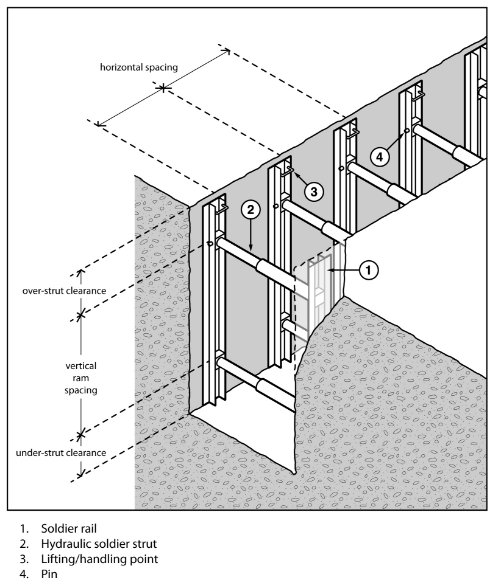
Steel sheet piling is generally used on major excavations such as large building foundations
or where large embankments are to be held back and can be installed prior to excavation work commencing. It is also used where an excavation is in close proximity to adjoining buildings
(see Figure 13).
Sheet piling may be used when the ground is so unstable that side wall collapse is likely to occur during excavation, for example in loose and running sand. In such cases, sheet piling should be installed before excavation commences.
Figure 13 Steel sheet piling
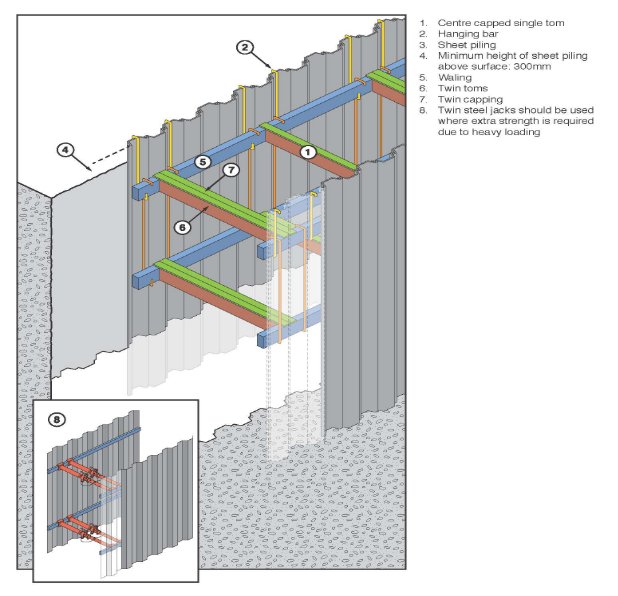
Other methods of excavation may require the use of steel trench sheeting or shoring.
It is positioned and pneumatically driven in to final depth. Toms and walings are placed
into position as the soil is excavated. Although timber can be used it is more efficient to
use adjustable jacks or struts (see Figure 14).
Steel trench sheeting is lighter weight than normal sheet piling and in some circumstances
may be driven by hand-held pneumatic hammers or electrical operated vibrating hammers.
The potential for manual handling injuries to occur in this operation is very high, as is the risk
of lacerations due to sharp metal protrusions. These risks should be addressed prior to commencement of driving the steel sheet. Any projections on the underside of the anvil
of jack hammers should be removed to prevent damage to the driving cap and potential injury
to the operator.
During driving operations, if it is likely that workers may be exposed to noise levels in excess
of the exposure standard, a method of controlling the noise exposure is required.
Steel shoring and trench lining equipment should be designed by a competent person. Further information on steel shoring can be found in AS 4744.1: Steel shoring and trench lining – Design.
Figure 14 Steel trench sheeting and jacks

The soldier set is a simple form of trench support set which can be formed with steel or timber. This system is mostly used in rock, stiff clays and in other soil types with similar self-supporting properties.
Unlike closed sheeting sets, soldier sets retain the earth where there may be a fault in the embankment. Soldier sets only provide ground support at regular intervals and do not provide positive ground support to the whole excavated face. Open soldier sets are only suitable for use in stable soil types. (see Figure 15).
Figure 15 Timber soldier sets
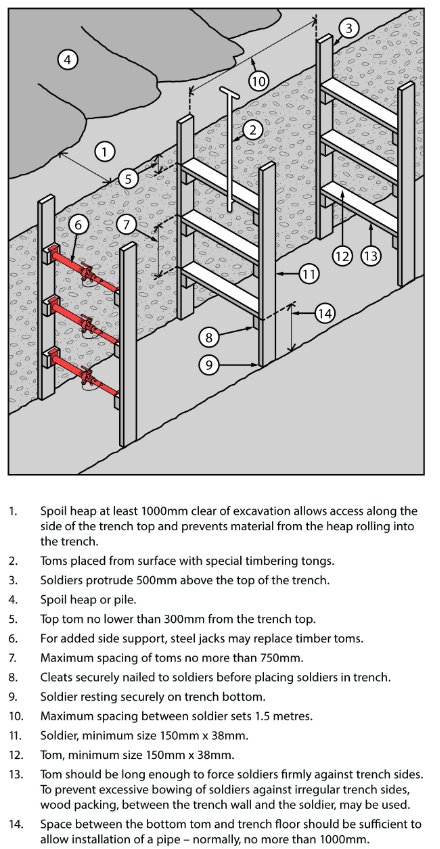
Closed sheeting is where vertical timber or metal members are used to fully cover and support
a trench wall and which are in turn supported by other members of a ground support system.
Figure 16 Example of closed sheeting
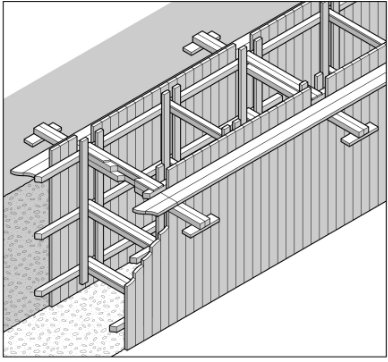
Side lacing is a form of closed sheeting used primarily to ensure worker safety by preventing soil from slipping by the placement of fill behind timber boards or steel plates (see Figure 17). Side lacing is used in all types of ground, and is particularly useful where long or large diameter pipes are to be installed and in variable ground conditions where steel or timber supports are difficult to install. Side lacing should be firmly wedged into the ground to prevent it from moving when fill is placed against it.
When closed sheeting or side lacing is used to prevent ground collapse, workers should not:
- enter the excavation prior to the installation of the sheeting/lacing
- work inside a trench, outside the protection of sheeting/lacing
- enter the excavation after sheeting/lacing has been removed, and
- enter an area where there is sheeting/lacing, other than by a ladder.
Figure 17 Side lacing in sand trench
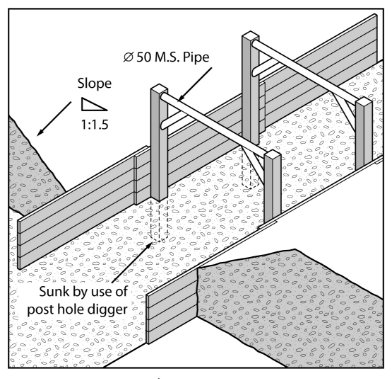
A ground anchor is a tie back to the soil behind the face requiring support and is typically used
with steel sheet piling (see Figure 18). Ground anchors may be installed in either granular
or clay soils. The design of ground anchors should be carried out by a competent person,
for example a geotechnical engineer.
In granular soil, the anchorage zone is usually a plug of grout located behind the active soil limit line. This plug resists the tension force induced in the stressing cables, due to the shear and cohesion forces developed along its length.
These forces can be due, in part, to the overburden. Removal of soil above installed ground anchors should only be carried out after approval has been received from a competent person.
Figure 18 Ground anchors for supporting steel sheet piling
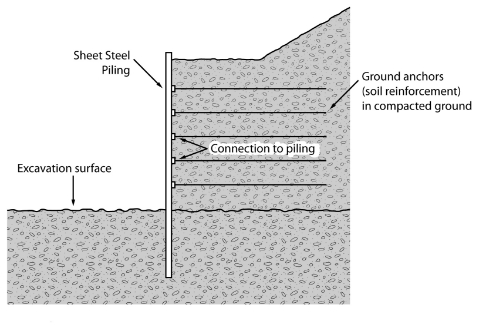
Removal of the soil between the retaining wall and the active soil limit line may cause sheet piling to bend. This bending will release the load in the stressing cable, and render the ground anchor useless and dangerous to workers in the excavation area.
The ground anchor may not develop its original load carrying capacity on replacement of the soil. The anchorage of the stressing cable at the face of the sheet piling may be also dislodged or loosened. This depends on the type of stressing cable and the respective anchoring systems. While the ground anchoring system is operative, periodic checks with hydraulic jacks and pressure gauges are used to assess anchor behaviour over long periods.
Shoring and all support systems should be removed in a manner that protects workers from ground collapse, structural collapse or being struck by structural members. Before removal begins, temporary structural members may need to be installed to ensure worker safety.
When removing shoring, the support system should be extracted or dismantled in reverse
order to its installation. Persons performing the work in the excavation should not work outside the protection of the ground support system. No part of a ground support system should be removed until the trench is ready for final backfill and compaction.
A shield is a structure, usually manufactured from steel, which is able to withstand the forces imposed by a ground collapse and protect workers within it. Shields can be permanently installed or portable and designed to move along as work progresses.
Many different shield system configurations are available for hire or purchase. Figure 19 shows
a typical trench shield.
Figure 19 Typical trench shield
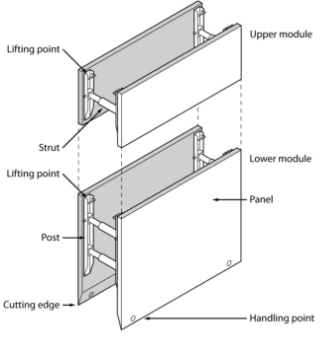
Shields and boxes used in trenches are often referred to as trench shields or trench boxes,
and are designed and constructed to withstand the earth pressures of particular trench depths and ground types. They incorporate specific lifting points for installation and removal.
Trench shields and boxes differ from shoring as shoring is designed to prevent collapse where shielding and boxes are only designed to protect workers if a collapse occurs.
Trench shields and boxes are useful where other forms of support are not reasonably practicable to install. They are mainly used in open areas where access is available for an excavator or backhoe to lower and raise the boxes or shields into and out of a trench. They are generally not suitable where as access is difficult and ground conditions prevent the use of lifting equipment.
Steel boxes for trench work can be light or heavy duty construction depending on the depth
of the trench and ground conditions. Trench shields and boxes should be designed by a competent person, for example an engineer, and be pre-manufactured to job specific dimensions.
Used correctly, shields and boxes can provide a safe work space for workers needing to enter
an excavation. Trench shields and boxes should be adequately maintained or they may fail unexpectedly, particularly if they have been abused or misused. The manufacturer’s instructions for the installation, use, removal and maintenance of shields and boxes should always be followed.
Trench boxes should not be subjected to loads exceeding those which the system was designed to withstand. Earth pressures are reduced when correct benching and battering practices are used.
Shields and boxes should be stored and transported in accordance with the manufacturer’s instructions. Heavy duty equipment may require disassembly for transport.
Boxes should be regularly inspected for damage. They should only be altered or modified with the approval of a competent person.
Support to the face of an excavation can sometimes be effectively provided by the use of chemical stabilisation techniques. These techniques involve injection under pressure of chemical solutions which bind and solidify soil. This method of stabilisation is only possible in porous soils.
The condition of soil surrounding excavations can change quickly due to the soil drying out, changes in the water table or water saturation of the soil. The soil condition and the state of shoring, battering and trench walls should be frequently checked by a competent person for signs of earth fretting, slipping, slumping or ground swelling. Where necessary, repair the excavation or strengthen the shoring system from above before allowing work below ground to continue.
Barrier means a physical structure which blocks or impedes something.
Barricade means any object or structure that creates a barrier obstacle to control, block passage or force the flow of traffic in the desired direction.
Backfill means material used for refilling excavations.
Battering means to form the face or side or wall of an excavation to an angle, usually less than the natural angle of repose, to prevent earth slippage.
Bench means a horizontal step cut into the face or side or wall of an excavation to provide horizontal bearing and sliding resistance.
Benching means the horizontal stepping of the face, side, or wall of an excavation.
Closed sheeting means a continuous frame with vertical or horizontal sheathing planks placed side by side to form a continuous retaining wall supported by other members of a support system used to hold up the face of an excavation.
Competent person means a person who has acquired through training, qualification or experience the knowledge and skills to carry out the task.
Earthmoving machinery means operator controlled mobile plant used to excavate, load, transport, compact or spread earth, overburden, rubble, spoil, aggregate or similar material, but does not include a tractor or industrial lift truck.
Exclusion zone means an area from which all persons are excluded during excavation work.
Face means an exposed sloping or vertical surface resulting from the excavation of material.
Geotechnical Engineer means an engineer whose qualifications are acceptable for membership of the Institution of Engineers, Australia and who has qualifications and experience in soil stability and mechanics and excavation work.
Hoist means an appliance intended for raising or lowering a load or people, and includes an elevating work platform, a mast climbing work platform, personnel and materials hoist, scaffolding hoist and serial hoist but does not include a lift or building maintenance equipment.
Overburden means the surface soil that must be moved away.
Operator protective device means a roll-over protective structure (ROPS), falling object protective structure (FOPS), operator restraining device and seat belt.
Powered mobile plant means plant that is provided with some form of self-propulsion that is ordinarily under the direct control of an operator.
Safe slope means the steepest slope at which an excavated face is stable against slips and slides, having regard to the qualities of the material in the face, the height of the face, the load above the face and the moisture conditions for the time being existing.
Shaft means a vertical or inclined way or opening from the surface downwards or from any underground working, the dimensions of which (apart from the perimeter) are less than its depth.
Sheet piling means vertical, close-spaced, or interlocking planks of steel, reinforced concrete or other structural material driven to form a continuous wall ahead of the excavation and supported either by tie-backs into solid ground structural members from within the excavation as the work proceeds.
Shoring means the use of timber, steel or other structural material to support an excavation in order to prevent collapse so that construction can proceed.
Soldier means vertical upright steel or timber element used for supporting a trench wall.
Strut means structural member (usually horizontal) in compression resisting thrust or pressure from the face or faces of an excavation.
Tom means structural member used to hold soldiers against a trench wall or to press walers apart in a close sheeted trench.
Trench means a horizontal or inclined way or opening:
- the length of which is greater than its width and greater than or equal to its depth; and
- that commences at and extends below the surface of the ground; and
- that is open to the surface along its length.
Trench box means a structure with four vertical side plates permanently braced apart by bracing designed to resist the pressure from the walls of a trench and capable of being moved as a unit.
Trench shield means a steel or metal structure with two vertical side plates permanently braced apart by cross frames or struts designed to resist the pressure from the walls of a trench and capable of being moved as a unit.
Tunnel means an underground passage or opening that is approximately horizontal and commences at the surface of the ground or an excavation.
Waler means a horizontal steel or timber element used for supporting a trench wall.
Water scouring means an erosion process resulting from the action of the flow of water.
Zone of influence means the volume of soil around the excavation affected by any external load (for example vehicles, plant, excavated material).











